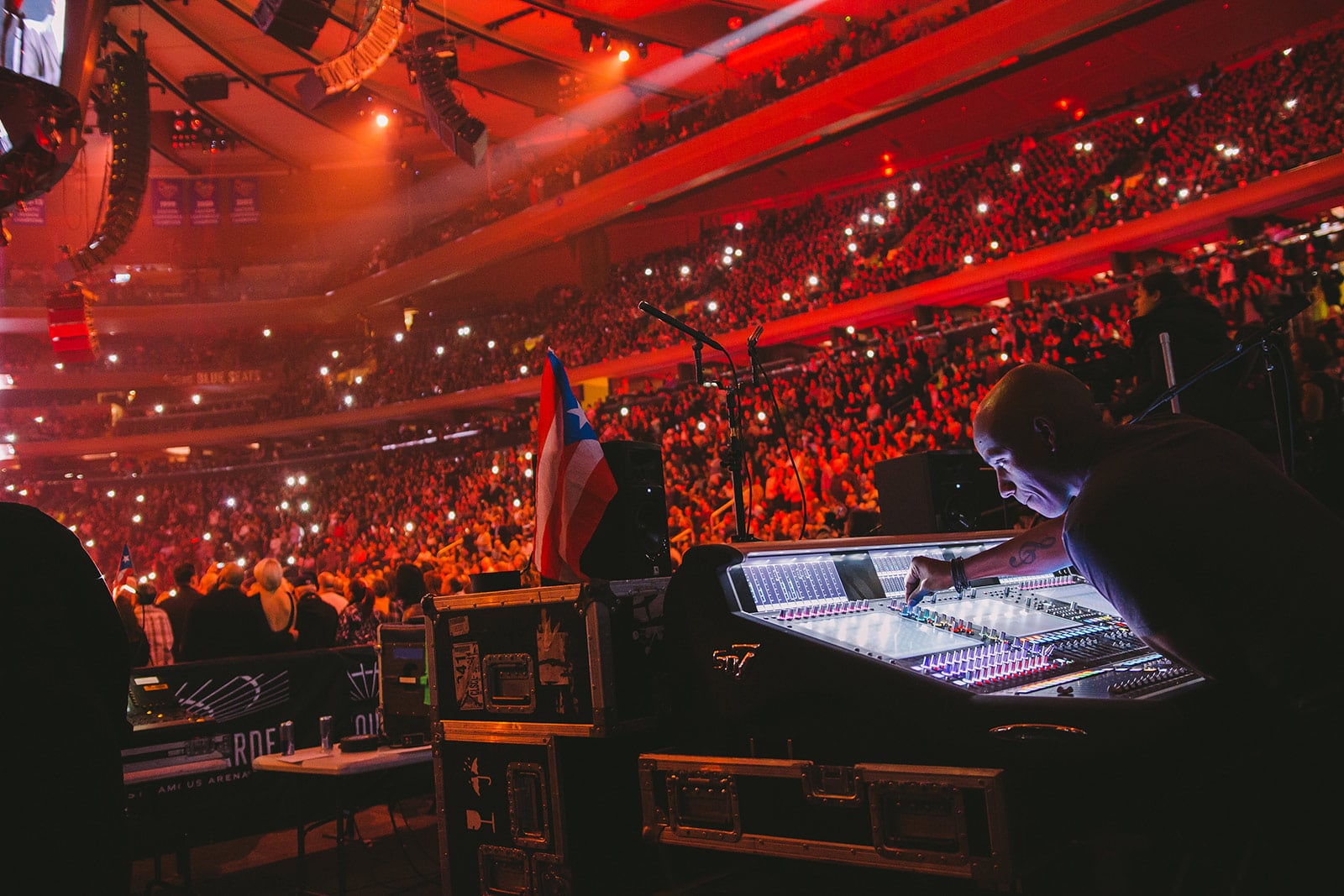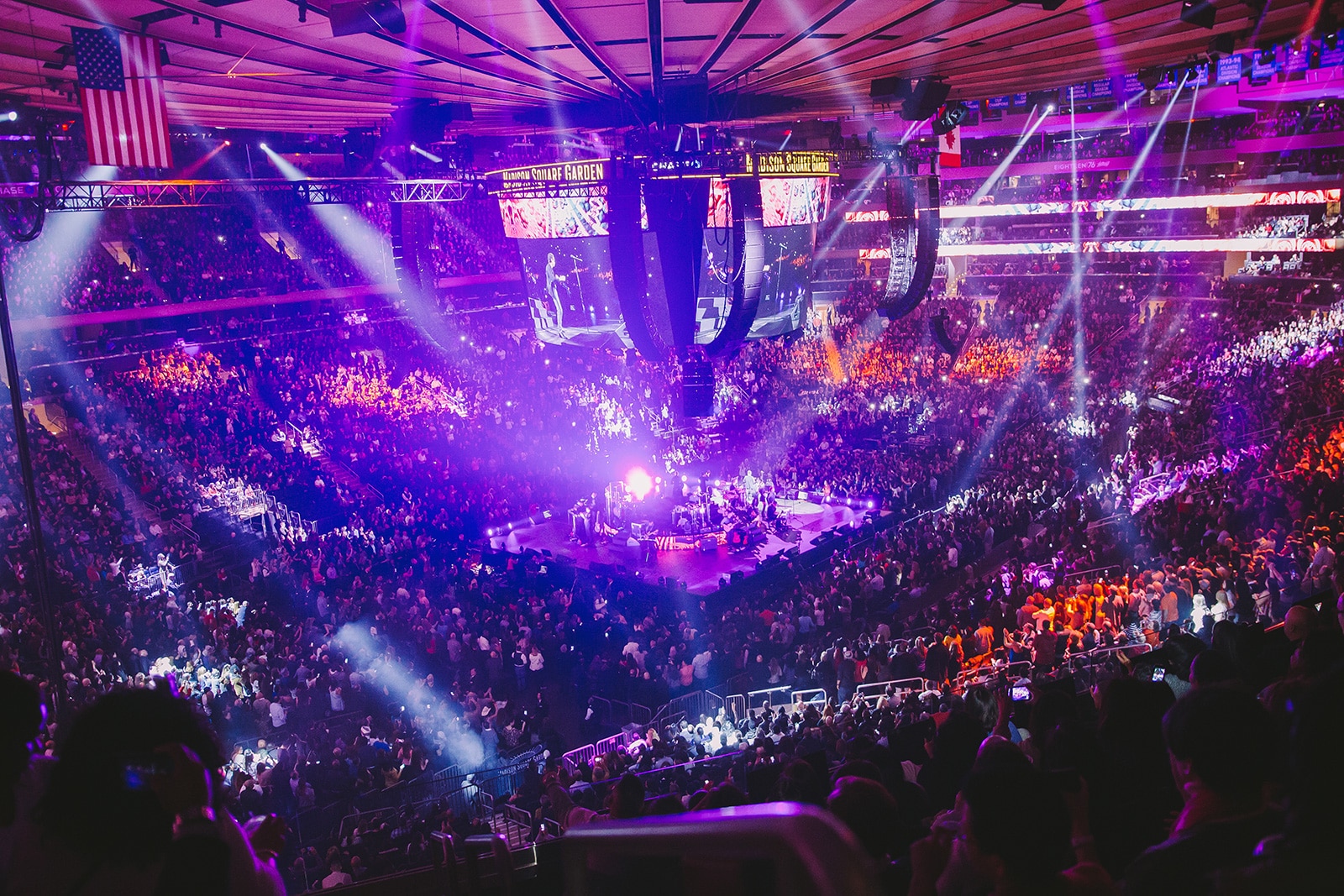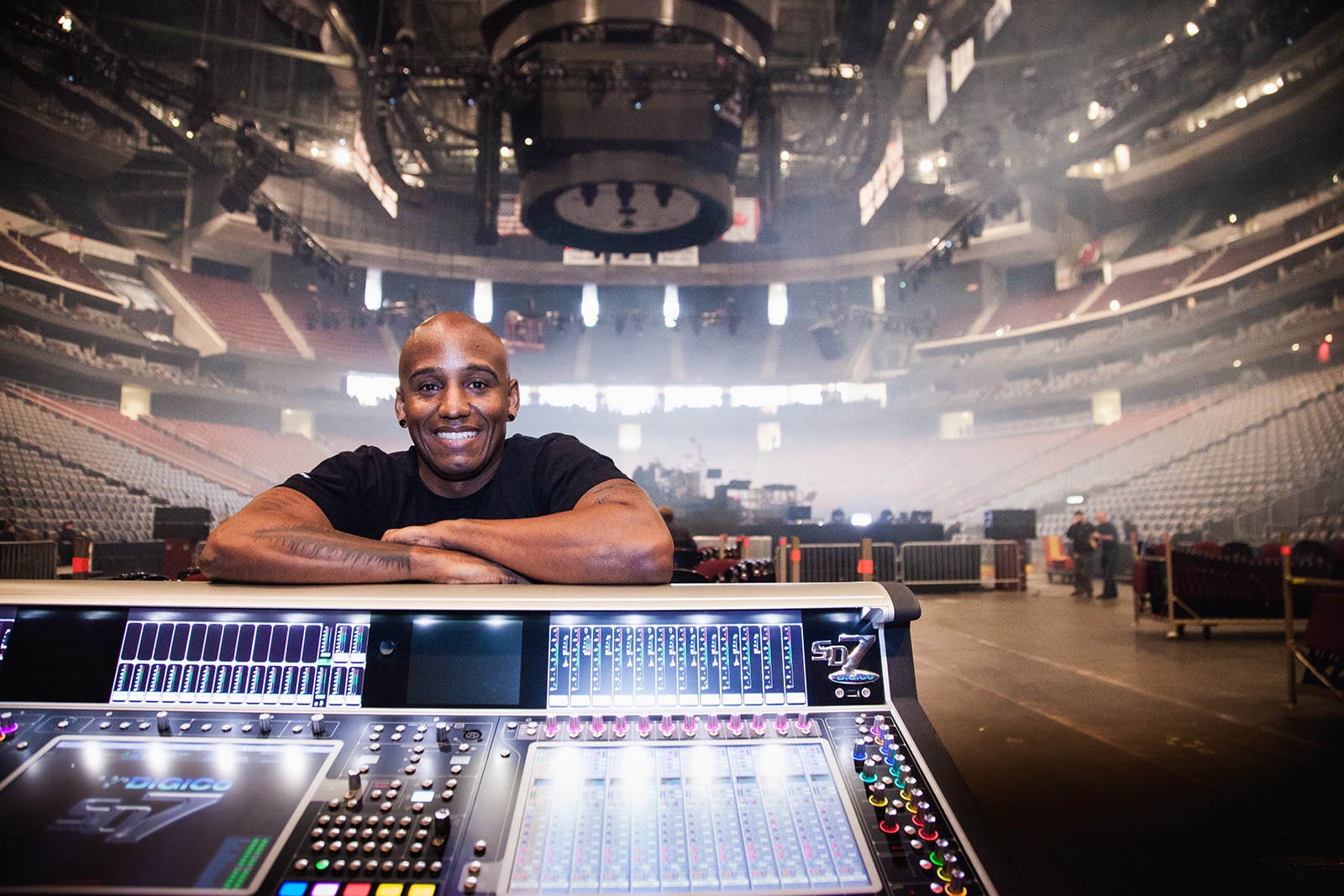With the LEO Family, Meyer Sound has not forgotten about the fundamentals of speaker design. There is a lot of depth and emotion that I'm getting out of the LEO/LYON rig. This allows me to deliver to the audience the essence of what is being expressed on stage.”
Jose RiveraFOH Engineer, Marc Anthony
Featured Products
1100-LFC, LEO, LYON, MINAJose Rivera is the long-time FOH engineer for Marc Anthony, the Latin music superstar who has won two Grammys, five Latin Grammys, and holds two Guinness World Records for tropical/salsa album sales. For the past two years, Anthony has been touring North America with a Meyer Sound LEO Family sound reinforcement system supplied by VER Tour Sound.
Rivera shares the challenges and rewards of his work and his past experience as both a studio and live sound mixer. This interview was conducted soon after Marc Anthony’s sold-out Valentine’s concert before an ecstatic audience of 19,000 at New York’s Madison Square Garden.
Q: How did it feel to be back at Madison Square Garden?
Rivera: It felt great. It was a big occasion for Marc, as his last concert in the Garden was September of 2010, and it had been even longer since he’d done his annual Valentine’s concert there.
Q: It certainly turned into a big party. Was it hard to keep the mix above the crowd?
Rivera: It was a challenge. By the second song it seemed like all 19,000 fans were singing along and competing with Marc’s vocal. I was concerned because when we’ve had negative reviews in the past they usually said that Marc’s voice couldn’t be heard clearly. That’s one of the reasons why we continue to use a Meyer Sound LEO Family system. It’s the best rig for translating Marc’s vocal throughout the arena.
Q: How was the system configured for the show?
Rivera: For 360-degree coverage, on this one we did eight hangs of eight LEOs and eight LYONs each. And we used MINA for front fills around the stage front.
Q: Was this your first 360-degree show in the Garden?
Rivera: Yes it was, and I thought the room behaved quite well acoustically. It really showed off the capabilities of the LEO system. It was probably the best-sounding 360-degree show we’ve done to date. I remember when we finished tuning, our system engineer, Jimmy Ibanez, came back from walking the room and said, “The coverage is smooth everywhere. I really enjoy using this rig.”
Jimmy deserves a lot of credit for our success. Night after night he makes sure there’s consistency in the rig, and Eric “Pyle” Ramey on monitors makes sure the performance from the band is top notch. We are a team, and we depend on each other to make it happen.
Q: Is Marc doing more 360-degree shows lately?
Rivera: Yes he is, and I don’t think it’s going to go away. Marc loves the fact that he feels closer to the audience, and the promoters love it because it increases the number of seats they can sell. The band is hesitant, because they are in a circle facing outward with their backs to each other. Part of the magic of the band is the way they interact, so in the 360-degree staging it can be a challenge.
Q: Is the quality of the PA particularly important for the 360-degree staging?
Rivera: Yes, the clarity and linearity of LEO and LYON is extremely helpful for the 360-degree arena shows. Knowing that high/high mids are delivered clearly and smoothly throughout the arena—despite the multiple reflective zones—gives me the ability to keep Marc’s vocal as the focal point of the mix without sacrificing the energy of the band. I prefer to have the LEO Family for any of the 360-degree arena shows, hands down.
Q: I understand that your preference for a LEO Family PA also is based in part by what is heard on stage.
Rivera: Any sound returning to the stage from behind the arrays is a major factor for Marc and the band. With previous PA systems, I constantly received complaints from the band and Marc that they were just swimming in low mids. To make a long story short, when we started using the LEO Family rig early last year, that issue went away. From that point on I have not heard any complaints from Marc or the band.
Q: Speaking of the band, it’s a good-sized ensemble.
Rivera: Not including Marc, we have 15 musicians on stage. There are four background vocalists (the fourth doubles as a keyboardist), and 12 musicians. We have a total of 45 microphones and 10 direct inputs on stage.
Q: How do you go about mixing a band like this, getting everybody heard in their proper place while keeping vocal clarity on top of it?
Rivera: Well first, I have the privilege of working with an amazing band. They are all first-rate musicians. That makes my life a whole lot easier, because they’re consistent in their performance. I’m not chasing them in the mix throughout the show.
My main approach is to achieve separation of each instrument. I use minimal panning along with separation within the frequency range by applying strategic EQ-ing to give each instrument clarity and a distinct tonality. That’s one reason I place a lot of emphasis on micing technique—matching the mic with the instrument, and ensuring the proper placement of every mic—which is why I do mic placement myself.
Q: Did you get this awareness of mic technique from your studio days? I understand you started in recording when quite young.
Rivera: Yes, I was 13 when I first walked into a recording studio in New York. A friend of the family—a singer who was releasing an album—saw my interest in music and electronics and invited me to the studio. I remember my parents dropping me off and meeting the studio owner, where I started as an assistant. That was the biggest and most influential day of my life.
It’s funny how things work out, because Sergio George—who was just starting college at the time—was one of the studio’s resident keyboard players. Later, he became Marc Anthony’s record producer.
Q: How did you get started in live sound mixing?
Rivera: When I was 15, the husband of one of the singers at the studio had just started a sound company. He saw me working, and asked if I was interested in live sound. The company was new and only had four loudspeakers to start—they mostly did club shows, and I primarily mixed monitors. In fact, I did my first show at Madison Square Garden when I was 17, a multi-artist showcase for artists on the same record label that later released Marc’s first album, which was produced by Sergio George!
Q: And how did you first start working with Marc?
Rivera: When Marc did a record release concert for his first album, Sergio remembered me and felt comfortable with me doing the FOH mix. It was at a large club called The Roxy, and for that show I mixed house and monitors from the same console. That was around 1991. I travelled with Marc a lot for a while, including some international tours. I was never home and I saw myself missing out on being a dad, so I made the decision to move to Miami and focus on studio work. After about 10 years, once our youngest child started kindergarten, I decided to do live sound work again. I was mixing the Latin Billboard Awards show in Puerto Rico when Marc and I reconnected, and I’ve been his FOH engineer since 2010.
Q: Do you find it helpful to split your time between live concerts and the studio? Does this influence what you hear and how you work?
Rivera: Yes, it’s very helpful. It influences my mixing style and what I listen for a lot. I have to mention that in my mix studio I’ve had many different monitor speakers, but recently I started using the Meyer Sound HD-1s. Even though it’s a design that’s been out for more than 25 years, I couldn’t believe what I was hearing—the depth of the sound is hard to explain. For me, they open up a whole new dimension in listening.
It was almost a surreal situation. With so many new designs out in the market, why would I fall in love with a design that was created a quarter century ago? But I think, whether it’s the HD-1 or the LEO rig, it goes back to building on a sound philosophy, paying attention to fundamentals, and then translating that into a product. That’s what I admire most about Meyer Sound as a company.
Q: We’ve heard other FOH engineers make that comparison, saying the LEO Family loudspeakers sound like big studio monitors.
Rivera: I’m not surprised, because with the LEO Family, Meyer Sound has not forgotten about the fundamentals of speaker design. There is a lot of depth and emotion that I’m getting out of the LEO/LYON rig. This allows me to deliver to the audience the essence of what is being expressed on stage. Other systems may have interesting new features, but that may come at the expense of design fundamentals. Because of this I tend to be cautious with new products that just seem to offer new bells and whistles.
Again, it’s similar to what I hear when mixing on a vintage analog console. Yes, it’s great to have all the flexibility and features of the new digital board, but you don’t want to compromise the fundamental sound, the emotion you get out of the music. And I don’t feel like I’m ever compromising with the DiGiCo console or the Meyer Sound system.




